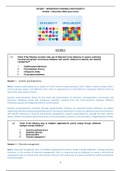IOP2607 – WORKGROUP DYNAMICS AND DIVERSITY
October / November 2018 exam memo
SECTION A
Answer: 1 - Systems psychodynamics
Notes: Systems psychodynamics is based on Freud’s work on psychoanalysis, Klein’s object relations theory, Bion’s
work on groups, Jaques’s and Menzies Lyth’s work on organisations as social defences, the group relations theory as
well as the open systems theory.
Systems psychodynamics allows for the study and interpretation of collective, interdependent unconscious and
conscious individual, group and intergroup processes resulting from the interconnection between different
individuals, groups and subgroups within a social system
Systems psychodynamics, primarily through psychoanalytic thinking, use observed human behaviour to explore
underlying individual and group psychodynamics (unconscious behaviour) in order to understand conscious behaviour
with specific reference to diversity and diversity management. Systems psychodynamics, through the open systems
theory, allows us to explore certain structures, such as boundaries, authority, roles and tasks, in organisational context.
Answer: 4 – Diversity management
Notes: Diversity management aims to establish organisational cultural change through deliberate, strategic diversity
initiatives. In the context of diversity management, this is a long-term process designed to create a multicultural
organisation with an environment and practices that are more responsive to a diverse workforce and its contribution
to business goals.
1
, Answer: 1 – differences & similarities, based on primary & secondary dimensions, between individuals & groups
Notes: Diversity is therefore a relational phenomenon that focuses on:
- the similarities and differences, based on primary and secondary dimensions between individuals and groups
- the manner in which individuals perceive, interpret and act upon these similarities and differences
Answer: 4 - unconscious
Notes: (In relation to conscious & unconscious behaviour – The iceberg model): According to Freud, human behaviour
is motivated by instincts, namely life instincts (eros) and death instincts (thanatos). We aren’t consciously aware of
these instincts, because they are located in the unconscious. The life and death instincts are major driving forces of
our behaviour and exert a continuing influence on our actions and conscious experiences. Thus, the unconscious
contains anxieties which are the major driving force behind people’s behaviour and is the basis for explaining conscious
behaviour.
Answer: 2 – Splitting
Notes: The following immature Individual defence mechanisms include:
1. Splitting: Splitting is a process of dividing feelings in order to deal with internal conflicts & anxieties.
2. Introjection: Projected feelings may be “taken in” by others, which is a process known as introjection. When
feelings have been introjected, recipients may be unable to distinguish between them and their own feelings
those that have originated within them.
3. Introjective identification: refers to an unconscious interpersonal interaction in which the individual seems to
identify with a feeling that was projected onto him- or herself.
4. Projective identification: When an individual introjects the feelings of others, the projected feelings may be
used by the individual as rationales for her/his own actions.
2




